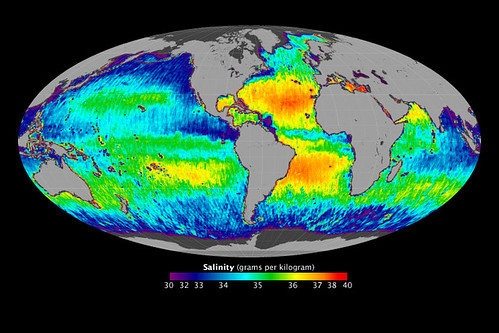 Changes in ocean salinity patterns recorded in one year of surface data captured by NASA's Aquarius instrument have revealed some surprises, scientists say.
Seasonal changes have seen pulses of freshwater gush from the Amazon River's mouth; an invisible seam divide the salty Arabian Sea from the fresher waters of the Bay of Bengal; and a large patch of freshwater appears in the eastern tropical Pacific in the winter, NASA scientists said.
Changes in ocean salinity patterns recorded in one year of surface data captured by NASA's Aquarius instrument have revealed some surprises, scientists say.
Seasonal changes have seen pulses of freshwater gush from the Amazon River's mouth; an invisible seam divide the salty Arabian Sea from the fresher waters of the Bay of Bengal; and a large patch of freshwater appears in the eastern tropical Pacific in the winter, NASA scientists said.
"With a bit more than a year of data, we are seeing some surprising patterns, especially in the tropics," Aquarius Principal Investigator Gary Lagerloef of Earth & Space Research in Seattle said. "We see features evolve rapidly over time."
Launched June 10, 2011, aboard the Argentine spacecraft Aquarius/Satelite de Aplicaciones Cientificas, Aquarius has been observing salt content of ocean surface waters.
Salinity variations, one of the main drivers of ocean circulation, are closely connected with the cycling of freshwater around the planet, scientists said, and the Aquarius data is providing valuable information on how the changing global climate is altering global rainfall patterns.
"The Aquarius prime mission is scheduled to run for three years but there is no reason to think that the instrument could not be able to provide valuable data for much longer than that," Gene Carl Feldman, Aquarius project manager at NASA's Goddard Space Flight Center in Greenbelt, Md., said. "The instrument has been performing flawlessly and our colleagues in Argentina are doing a fantastic job running the spacecraft, providing us a nice, stable ride."
Read more: http://www.upi.com/Science_News/2013/02/28/NASA-instrument-scans-ocean-salinity/UPI-57921362098981/#ixzz2MIrNh0ra
Read more: http://www.upi.com/Science_News/2013/02/28/NASA-instrument-scans-ocean-salinity/UPI-57921362098981/#ixzz2MIrHjt00
Source: UPI.com
Image courtesy of NASA Earth Observatory via Flickr (CC BY 2.0)
